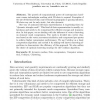Free Online Productivity Tools
i2Speak
i2Symbol
i2OCR
iTex2Img
iWeb2Print
iWeb2Shot
i2Type
iPdf2Split
iPdf2Merge
i2Bopomofo
i2Arabic
i2Style
i2Image
i2PDF
iLatex2Rtf
Sci2ools
AMDO
2010
Springer
2010
Springer
Analysing the Influence of Vertex Clustering on PCA-Based Dynamic Mesh Compression
Abstract. The growth of computational power of contemporary hardware causes technologies working with 3D-data to expand. Examples of the use of this kind of data can be found in geography or gaming industry. 3D-data may not be only static, but also dynamic. One way of animated 3D-data representation is expressing them by "dynamic triangle mesh". This kind of data representation is usually voluminous and needs to be compressed for efficient storage and transmission. In this paper, we are dealing with the influence of vertex clustering on dynamic mesh compression. The mesh is divided into vertex clusters based on the vertex movement similarity and compressed per-partes to achieve higher compression performance. We use Coddyac as a basic compression algorithm and extend it by adding well known clustering algorithms to demonstrate the efficiency of this approach. We also addres the choice of optimal clustering strategy for the Coddyac algorithm.
| Added | 20 Mar 2011 |
| Updated | 20 Mar 2011 |
| Type | Journal |
| Year | 2010 |
| Where | AMDO |
| Authors | Jan Rus, Libor Vása |
Comments (0)

